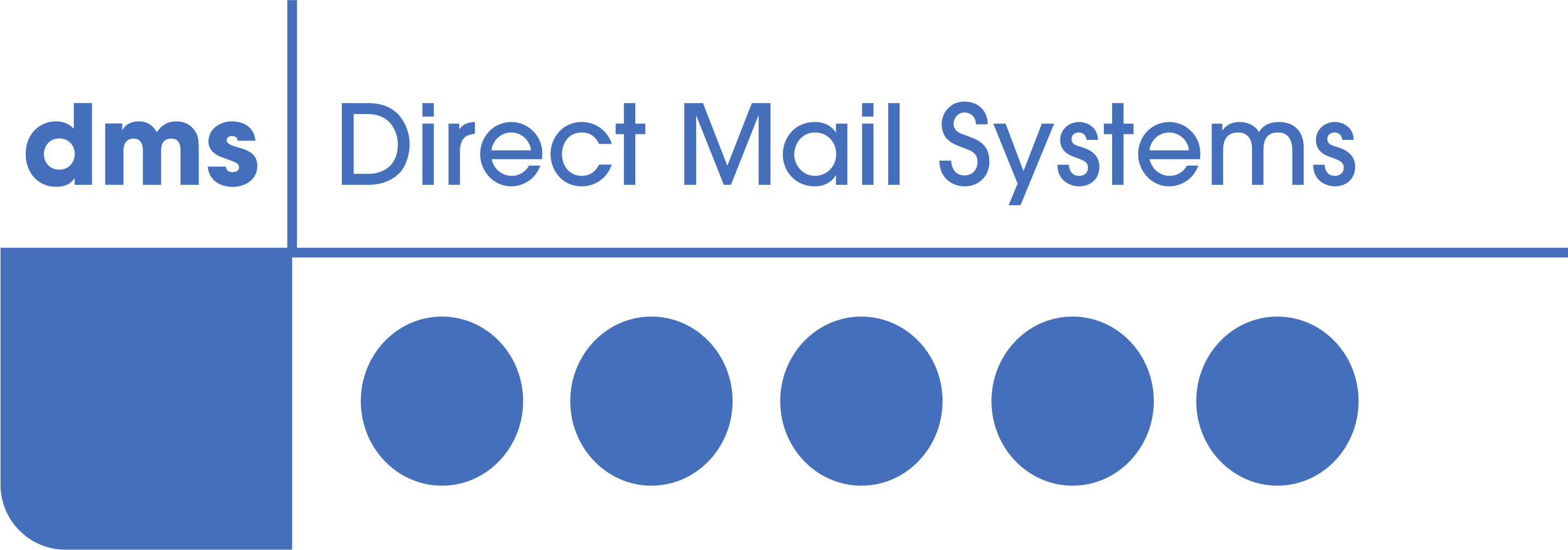Email campaigns and social media advertising are often thought of as the most efficient way to reach existing and prospecting customers and wonder about the fate of more traditional marketing methods like direct mail. The truth is, that direct mail marketing has seen a resurgence in recent years, as businesses see its capabilities in effective targeting and embrace tactics such as flyers and personalised mail. Therefore, as we look ahead the question arises: What is the future of direct mail? In this blog post, we’ll dive into our trends and predictions for direct mail and how we think it will reshare many marketing strategies within the coming year.
7 Direct Mail Predictions for 2025 and Beyond
As direct mail marketing continues to evolve, we’re seeing a unique blend of traditional marketing strategies and new technology advancements, to create a new era of direct mail marketing. According to the AA and WARC, UK ad spending on direct mail saw a 12.9% year-on-year growth in Q3 of 2024, marking its return to growth after a few years of decline and underscoring its renewed importance. Here are our direct mail predictions and trends for the coming year and beyond.
1. Sophisticated Personalisation
With the help of technology, direct mail has the capabilities to become even more sophisticated when it comes to personalisation, with the help of data analytics and AI technology. A major upcoming trend, heightened personalisation is set to be a key factor within many direct mail production strategies. It has already been shown that personalised direct mail can improve engagement, with it being found to drive a purchase by 6% in Q1 last year, a 43% growth year-on-year, according to JICMAIL data. It’s clear that adding an aspect of personalisation is no longer a ‘nice to have’, but an essential aspect to any strategy.
We can’t pretend that people don’t receive a lot of direct mail, they do! So it’s important that brands stand out from the competition and don’t blend into the crowd. This is done by creating relatable content for their audiences so that it speaks directly to the recipient. The enhanced ability to use variable data printing (VDP) means that every element, from the recipient's name in the header to specific product images and offers, can be unique.
A one-size-fits-all approach is therefore not enough to cut through the crowd and direct mail campaigns need to be personalised for each recipient’s relationship and history with the company. This can be achieved through utilising customer data and delivering personalised product recommendations or customised messages based on their past purchases, creating messages that rival that of digital channels. This level of sophistication is helping marketers shift from mass mailing to truly targeted, meaningful physical communication.
2. Utilising Analytics
We see the further utilisation of analytics within direct mail to be a major trend in the coming year. Just as with digital marketing channels, robust measurements and analytics can reveal key insights into audiences and campaign performance and further support future marketing decisions. Direct mail campaigns generate valuable data, but previously these were hard to access or measure. With recent data revealing that 38% of website visits prompted by mail converted into an online purchase, the pressure to accurately track and attribute this success is higher than ever.
The use of advanced analytics tools will enable in-depth analysis of direct mail campaigns, driving further understanding and insight into a campaign of what and what isn’t performing well. Other metrics and KPIs can also be measured with such tools, like ROI, response rates and conversion, creating a data-driven approach to aid maximum effectiveness and further optimisations. This is often achieved through unique codes, personalised URLs (PURLs), and specific call tracking numbers on the mail pieces, which seamlessly bridge the gap between the physical mailer and digital tracking systems. Understanding the full journey from mailbox to conversion is critical for proving direct mail's value.
3. Hyper-Targeting
A future trend for direct mail is hyper-targeting, which entails an even more targeted approach to campaigns, creating content and mailers that are highly relevant and specific to each recipient or audience segment. The use of advanced data analytics and even predictive modelling will allow businesses to identify and target niche audience segments with highly targeted messaging which will be incredibly relatable and drive an increased engagement rate, higher response rates and thus a good ROI.
Again, utilising the available customer data is key for a hyper-targeting approach. Companies can analyse last purchase data, online behaviour, and demographics and use this to craft highly relevant and personalised direct mailers that speak to each recipient. This is where services like partially addressed mail come into play, allowing brands to target specific households or postcodes based on demographic data, without needing named personal data.
The continuous development of artificial intelligence (AI) also provides opportunities for further hyper-targeting campaigns, by helping make predictive insights as well as automated processes. AI can predict which customer segments are most likely to respond to a particular offer or creative format, enabling marketers to allocate their budget more efficiently for an optimal return on investment.
4. Interactive & Multisensory Experiences
Providing an interactive and multisensory experience within a direct mail campaign will be a key trend for the coming year. Retaining and capturing the attention of recipients is key and therefore incorporating more opportunities to interact will drive increased engagement as well as improve accessibility. Incorporating augmented reality (AR), QR codes, near field communication (NFC) technology all create a more memorable and engaging experience. For example, a simple QR code on a postcard marketing piece can instantly lead a customer to a captivating video or a personalised microsite. Even incorporating more tactile and creative mailer designs will help to make a mailer stand out from the crowd such as 3D pop-ups, scented inserts and embossed paper. This shift towards physical engagement is validated by neuroscience studies, which show that printed materials activate deeper emotional processing than digital media, increasing brand recall.
5. Sustainable & Eco-Friendly Practises
Environmental impacts are a concern to everyone, but particular customers. Like all industries, more sustainability practices are a big trend and likewise within direct mail marketing. Research shows that customers are choosing more sustainable brands over those that don’t show to be making a positive environmental impact, with 78% of consumers feeling that sustainability is an important factor when shopping and 80% of consumers willing to pay more for sustainably produced goods. Furthermore, 84% of customers say poor environmental practices will alienate them from a brand, placing a high premium on green credentials.
This responsibility therefore transcends to a company’s direct mail campaigns, in which the use of more eco-friendly practises like using recycled materials, utilising carbon-neutral mailing, more sustainable printing methods, natural printing inks and minimising waste is more important than ever. Companies should actively communicate their commitment to the environment by highlighting the use of FSC-certified paper and responsible waste management, ensuring their choice of paper stock and finishes aligns with consumer values.
6. Integration with Digital Channels
Another trend for the future of direct mail is the further integration with digital channels. Many brands already use direct mail to complement their digital efforts but creating seamless integrations with email, social media and websites will be key to forming an omnichannel experience for customers that is consistent across all channels. In fact, data from Q4 last year shows that 8% of mail prompted a website visit, proving its effectiveness as a bridge to online engagement. For example, including QR codes on a direct mailer will enable a recipient to easily access a personalised landing page, therefore bridging the gap between the physical and the digital. This powerful synergy means that campaigns with mail in the mix are 52% more likely to report ROI benefits, as reported by Marketreach. The combination creates a highly effective, memorable, and measurable customer journey.
7. Automation & Triggered Direct Mail
Like all successful marketing campaigns, timing is everything. We predict the use of triggered and automated direct mail campaigns will be a major trend over the coming year, enabling the capitalisation of pivotal moments within a customer journey with minimal manual work needed from the sending company or brand. This process often relies on our digital printing capabilities, which allow for rapid, high-quality, and cost-effective print-on-demand.
Triggered direct mail will be automatically sent in response to a specific customer action or event that has taken place. For example, one year without a purchase, 3 months after the first purchase, a reminder triggered by an abandoned basket or for a customer’s birthday. This allows for an immediate response on key customer events to drive engagement and ROI and keeps a company or brand top of mind and relevant for the customer. This ensures that every piece of mail sent is contextually relevant, increasing the likelihood of a high response rate compared to a batch-and-blast approach.
What is the Future of Direct Mail?
The future of direct mail is very much alive and holds a whole host of opportunities with the support of innovation and developing technologies. By embracing the upcoming trends within direct mail, such as personalisation, hyper-targeting, sustainable practises and automation, businesses can really harness direct mail as a reliable and effective marketing channel that can offer ROI and engage customers in meaningful ways. As technology continues to evolve, so will direct mail, making it an exciting and modern marketing strategy that shouldn’t be overlooked. The unparalleled attention mail receives—132 seconds on average compared to just seconds for a digital ad—gives it a distinct advantage in today’s attention economy.
If you’re looking for support for your direct mail campaign, DMS are here to help. With extensive experience in all stages of direct mail campaigns, we can support you in all areas from printing and production, to data cleansing and delivery. Find out more or get in touch here.

